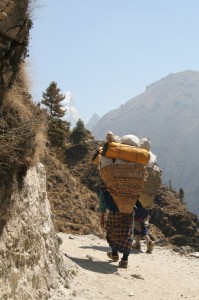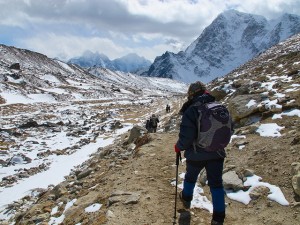Editor's Note: Many readers of Adventure Travel News have been following closely the news out of Nepal since the April 18 tragedy on Mt. Everest. For an industry grieving and pondering next steps, we offer this article as a "how-to" for a situation that has no best practice. This article originally appeared on the legal blog of ATTA member Mona McPhee and is reprinted here with full permission. Read the original here: The Tragedy On Mt. Everest – What Are Your Business Values And How Would You Respond?
Industry Professionals Respond to Everest Tragedy
 ATTA President Shannon Stowell spoke to Travel Weekly about the future of the climbing industry on Everest. We've excerpted his words here. Read the full article here: Travel professional recalls day of death on Mount Everest
ATTA President Shannon Stowell spoke to Travel Weekly about the future of the climbing industry on Everest. We've excerpted his words here. Read the full article here: Travel professional recalls day of death on Mount Everest
Since the tragedy, the deadliest accident in the history of Everest climbing, the Sherpas have effectively shut down the remainder of the season (which usually runs for a few short months in the spring) as they mourn the loss of their brethren and protest the risks they take vs. the compensation they get for bringing climbers to the 29,035-foot summit.
The government of Nepal was highly criticized for initially only giving the families of the fallen Sherpas $400 each as compensation for their loss in an industry that charges climbers tens of thousands of dollars for an attempt to summit.The Nepalese government has since looked into greater compensation for the families of the deceased Sherpas, and the adventure travel community is promoting fundraising initiatives to add to the assistance.
Shannon Stowell, president of the Adventure Travel Trade Association, said, “Good operators really take care of their Sherpas, both in pay and also by taking out life insurance policies on them for the families’ sake.”
Stowell added that while the recent tragedy dealt a serious blow to the adventure travel community, he hoped that, ultimately, the climbing industry will be able to continue in a way that is beneficial to all parties involved.
“Could the industry look into itself and see what risks can further be mitigated?” Stowell asked. “Sure, but … for the longer term, to close down climbing would have a devastating effect on the mini-economies that have sprung up around climbing — not only the guiding, but the lodging, restaurants, etc., that come along with it.”
Indeed, the adventure travel community expects that Everest will be up and running again for the 2015 season, and the climbing industry doesn’t appear to be going away anytime soon.
On Friday, April 18, 2014, a line of climbers, mostly high-altitude climbing Sherpas, “were backed up, carrying heavy loads of equipment for their clients,” in the Popcorn Field area of the Khumbu Icefall between Base Camp and Camp 1 on the Nepal side of Mt. Everest when an avalanche buried and killed sixteen Sherpas. At different moments during the grieving over this tragedy, questions of “value” will be posed, debated and grappled with: the value of human life, the value of specialized skills and services, the value of doing business by offering high-risk services, the value of supporting a family, and more. This blog post is intended to address only some of the business questions that high-risk adventure tour operators must face when a crisis of this magnitude occurs. You, however, are welcome to share your thoughtful, well-intentioned comments on the politics, financial, moral, spiritual, and other issues associated with this event.
The Mt. Everest avalanche highlights several different events that can occur outside of an operator’s control – a dangerous, natural condition became a real tragedy with lives lost; a highly-skilled, specialized group of people have been directly harmed and appear to have withdrawn their services; a government must respond and make decisions; and individual operators and climbers must make personal decisions about continuing the 2014 Everest climbing season, if possible.
How will you respond under similar circumstances?
Handling the impact on your business caused by this type of catastrophic event is a combination of:
- Internalizing and understanding how the guiding principles of your company apply in a crisis;
- Risk management planning;
- A communications strategy; and
- Knowing what you don’t know and having the resources lined up who will step in and help you with those matters.
When it comes to internalizing and understanding how the guiding principles of your company apply in a crisis I welcome the comment and questions of Dan Moore, CEO of Pandion Consulting and Facilitation, a consultant and knowledgeable conscience in the adventure travel world:
The recent tragedy at Mount Everest is exposing some of the inner workings of the high-elevation climbing world. Most people are aware that Sherpa guides are an integral part of the expeditions in the Himalayas. It would not surprise people that Sherpa guides make less than foreign guides. Are they aware that the Nepalese government receives about $3 million (U.S.) in royalties from permits to climb Everest? The demand from Sherpa guides is that the Nepalese government compensate families of fallen climbers at a much higher rate than is currently being offered. What responsibility do outbound tour operators have regarding social sustainability? Is client expectation enough to push operators to ensure their outfitters are adhering to labor standards? Or does perception shift too quickly to rely on staying ahead of demand? I believe that operators can avoid abrupt work stoppages and boycotts from prospective clients by inspecting their operations regularly to ensure labor standards and relations meet or exceed their values. Travel companies also have an opportunity to use their financial muscle to hold local governments accountable for upholding labor law and commitments to workers.
Also, consider the fact that when the potential for danger seems overwhelming, even drastic steps can be taken in order to maintain alignment with your principles. For example, “on May 7, 2012, [Himalayan Experience] made an announcement that shocked most of the thousand people camped at the base of Everest: he was pulling all his guides, members, and Sherpas off the mountain, packing up their tents and equipment, and heading home… [and clients] were forced to abandon their dreams of climbing the world’s highest mountain without receiving a refund for the forty-three thousand euros they had paid him in advance.” (J. Krakauer, “Death and Anger on Everest” The New Yorker, online blog posted Apr. 21, 2014 (link in Sources section at end of this post)).

Has your company examined its mission, principles, and values so that you are prepared to react, and even more importantly, contribute to the important value questions highlighted by a major catastrophe? If not, add that task to the agenda of your next executive or company-wide strategic planning process, especially if your company crosses cultures and supports the economic vibrancy of local communities. Then conduct regular due diligence with your suppliers that includes examining whether the operations “meet or exceed [your] values.”
Risk Management Planning
When any crisis occurs, whether a client is injured or a series of events result in the loss of life and possible cancellation of an entire season, your risk management planning allows you to strategically continue your operations and defray some of the cost of the crisis. A strong risk management plan includes:
- A Crisis Management Plan that states in detail how your operations will proceed and who is responsible for the various tasks in the event of a crisis.
- Tour Operator Professional Liability Insurance provides coverage for claims from your clients because they have suffered bodily injury or damage to their property.
- A medical evacuation and crisis services provider (e.g. Global Rescue or TravelGuard). This provider may offer evacuation services to your team and assistance in implementing your crisis management plan, including professional support for next of kin notifications and emotional strain suffered by your staff.
- Contracts with your clients. Prior to selling your tour your clients need to agree to your Terms and Conditions that include a “Force Majeure” clause releasing you from financial liability for your client’s purchase of the tour in the event the tour needs to be cancelled due to any circumstances beyond your reasonable control. These events are usually considered “acts of God,” major weather events or natural disasters, war, disease outbreak, labor strikes, and government mandates that make a tour not feasible to run or continue. Your clients also need to assume the risks of the tour and release you from certain liabilities through a waiver of liability and assumption of risk contract.
- Clear advertising and communications with clients. All operators, but especially those specializing in high-risk expeditions and adventures, should adopt total clarity about the risks of the tour in both your pre-purchase and pre-tour communications.
I asked Chun Wright of The Law Office of Chun T. Wright, PLLC based in Washington D.C. to contribute and she points out the importance of having a communications strategy in place well before a crisis happens:
The Everest and other recent travel-related tragedies have been fast-moving with no rest for those directly involved and certainly no time to develop a communications strategy from scratch. We have seen both excellent and poor communications in recent weeks; those entities that communicated effectively most certainly were aided by a well-thought out plan. During times of tragedy, if you have already devised a communications plan, then you have an opportunity to build loyalty with your constituents and credibility with the public at large through good communications even in the face of uncertainty and devastating loss. How well you as tour operator gather and disseminate information during difficult times like these will impact both your short-term and long-term resilience. In devising a communications strategy, your ultimate goal is to make sure your communications are clear, concise, accurate and timely.

In developing a communications strategy, consider these steps:
- Create an emergency response team and designate one person to be the company spokesperson. Your emergency response team should include members of the executive team, your operations manager, your marketing and communications staff, a crisis management specialist, on the ground staff, and legal.
- Determine how to obtain and record in-country information quickly and reliably, taking into consideration matters such as language barriers, available means of communication, and on-the-ground conditions.
- Determine the recipients of your message. Taking Everest for example, possible recipients include a) local guides, staff and trip leaders; b) current customers who are in-country and directly affected; c) current customers who plan to summit Everest or hike to Base Camp/the Himalayas in the future; d) members of the local Nepalese community with whom you interact or rely upon for assistance during trekking season and the community at large; d) the media; e) government officials in Nepal and elsewhere; f) the local adventure tourism community in Nepal; g) donors; and h) the public at large.
- Craft your message for each recipient group. In doing so, focus on the facts, i.e., “who, what, when and how.” Your staff is going to need to know how they should respond to the disaster if they are in Nepal and what they should communicate to customers. Customers are going to have questions about your refund/cancellation policy and whether it is safe to trek in Nepal. Customers and the media may also want to know your position on the social and political issues that have been highlighted by the tragedy and its aftermath such as the pay Sherpas receive and the risks they face on expeditions. These are important and sensitive issues and, as lawyers, we would try and steer your communications away from those in favor of focusing on the “who, what, when and how. “ That being said, addressing these issues to some degree may be appropriate and even desired for some tour operators while it may not be for others. It will depend on your particular circumstances and involvement in the underlying events.
- Decide how to disseminate your message and how to monitor social media for opportunities to distribute your message. Suitable modes may include a press release to media outlets, statements on your website and through social media, press conferences, letters to the government, etc.
- Disseminate your message in the various modes promptly.
- How are you going to support your team of employees and suppliers professionally, financially, and emotionally in the days and weeks following a major catastrophe?
- How can you help your supplier who is directly caught up in the crisis?
- Do you know what your insurance coverage includes? Do you have applicable first party business interruption coverage (some small businesses may have this)? Do you have applicable third party general liability coverage?
- Does your insurance cover your supplier as an Additional Insured? Does your supplier have insurance that covers you as an Additional Insured?
- How much support does your relationship with your medical, security, transport, and/or other critical services provider (e.g., Global Rescue or TravelGuard) offer to you?
- Is your client’s financial investment with you protected if the tour must be cancelled because of (a) acts of god, (b) government mandates, (c) work stoppages, or (d) other events outside your control?
- Are your clients’ financial investments with you protected if you make the decision to cancel tours?
- At what point must the cancellation occur in order for an insurance payout to be a viable option?
- Where in the supply chain is each client’s money? You need to know this if you have clients from those U.S. jurisdictions with Seller of Travel regulations (e.g. California, Florida, and Washington).
Inspiration: FaceBook posts by Ambrose Bittner of Red Lantern Journeys on the loss of his friend Dorje Khatri in the April 18th avalanche.
I send my prayers to those who are suffering from loss and injury and to the communities that are grappling with the challenges highlighted by this tragedy.
Namaste.
Sources: The news and available information relating to the April 18th tragedy and its aftermath continue to evolve.Arnette, Alan, “Tragedy Overwhelms Everest,” Apr. 21, 2014. http://www.alanarnette.com/blog/2014/04/21/everest-2014-tragedy-overwhelms-everest/
Associated Press, “Sherpas leave Everest; some expeditions nix climbs,” The Washington Post, Apr. 22, 2014 (updated 6:01 AM Apr. 23, 2014). http://www.washingtonpost.com/world/asia_pacific/sherpas-leave-everest-some-expeditions-nix-climbs/2014/04/23/179c630e-ca9e-11e3-b81a-6fff56bc591e_story.html
Barry, Ellen and Graham Bowley, “After Everest Disaster, Sherpas Contemplate Strike,” New York Times, Apr. 20, 2014. http://www.nytimes.com/2014/04/21/world/asia/after-everest-disaster-sherpas-contemplate-strike.html?_r=0
Hansman, Heather, “What Does It Cost to Climb Everest?” Outside Online, May 1, 2013.http://www.outsideonline.com/outdoor-adventure/climbing/mountaineering/everest-2013/What-Does-it-Cost-to-Climb-Everest.html?utm_medium=xmlfeed&utm_campaign=rss&utm_source=rss
Jenkins, Mark, “Climbing Finished for Season on Everest After Deadly Avalanche?” National Geographic Daily News online, Apr. 20, 2014. http://news.nationalgeographic.com/news/2014/04/140420-mount-everest-climbing-mountain-avalanche-sherpa-nepal/.
Krakauer, Jon, “Death and Anger on Everest” The New Yorker, online blog posted Apr. 21, 2014.http://www.newyorker.com/online/blogs/newsdesk/2014/04/everest-sherpas-death-and-anger.html.
Shrestha, Manesh, “Mount Everest climbing season up in air after avalanche deaths,” CNN online, Apr. 21, 2014 (updated 7:41 AM EDT). http://www.cnn.com/2014/04/21/world/asia/nepal-everest-avalanche/
